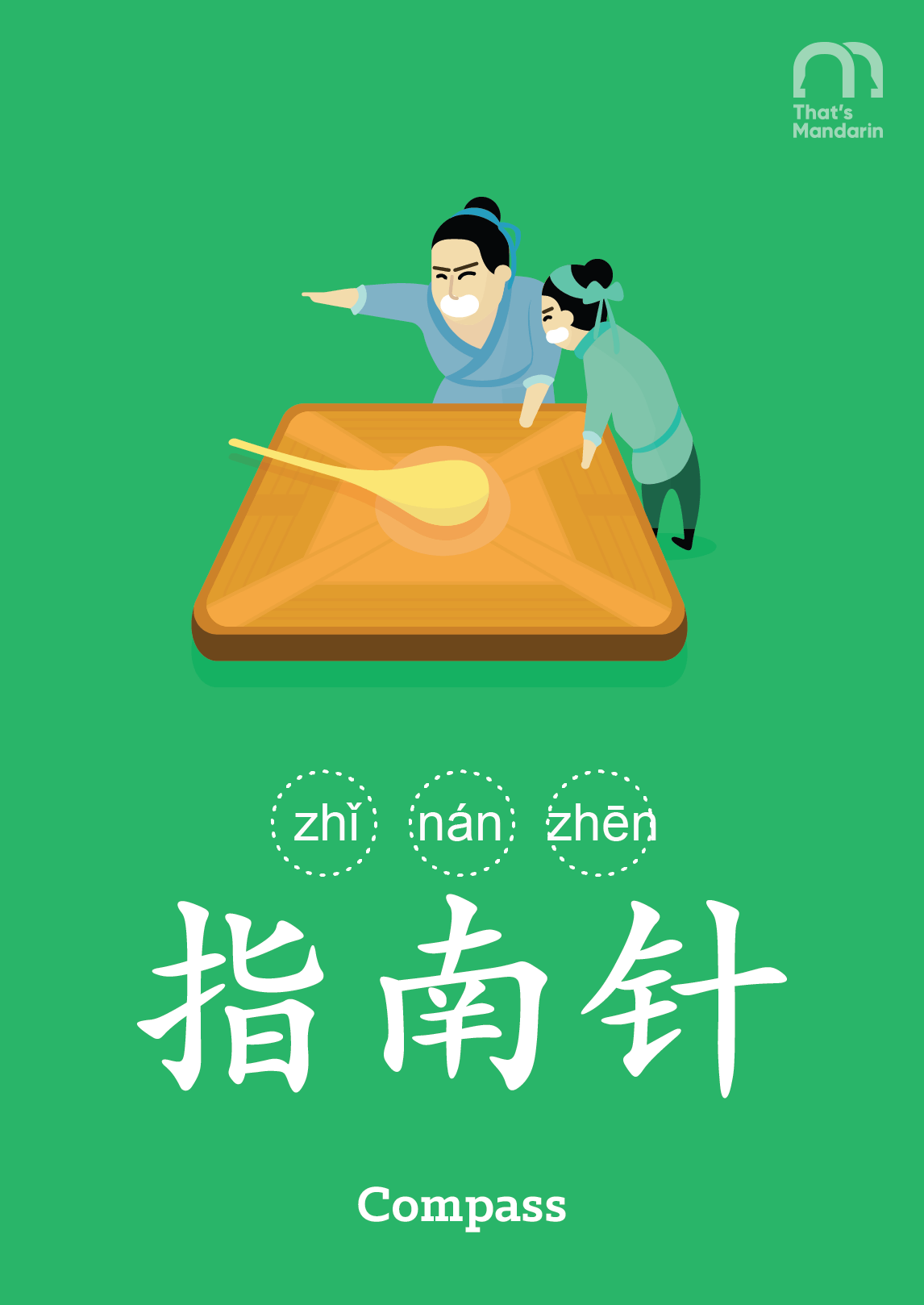Link Words: The 4 Great Chinese Inventions
The Four Great Inventions, or 四大发明 (Sì Dà Fāmíng), are inventions from ancient China that are celebrated in Chinese culture for their historical significance and work as symbols of ancient China’s science and technology.
四 (sì) · four
大 (dà) · big
发明 (fāmíng) · invention(s)
They are Compass, Gunpowder, Papermaking and Printing.
Link Words
The 4 Great Chinese Inventions
Compass | 指南针 (zhǐnánzhēn)
The first invention we are going to learn about is the Compass, 指南针 (zhǐnánzhēn, “pointing-south-needle”).
The earliest reference to a magnetic device used as a “direction finder” is in a Song Dynasty book dating back to AD 1040-44. The description consists of an iron “south-pointing fish” floating in a bowl of water, aligning itself with the south. The device is portrayed as a means of orientation “in the obscurity of the night.”
However, the first suspended magnetic needle compass was mentioned by Shenkuo in his book of AD 1088.
Gunpowder | 火药 (huǒyào)
Gunpowder, or 火药 (huǒyào), is one of the Four Great Inventions, 四大发明 (Sì Dà Fāmíng) in China.
It was discovered in the 9th century by Chinese alchemists searching for an immortality potion.
By the end of the 12th century, Chinese gunpowder formulas a level of nitrate capable of bursting cast iron metal containers, and took the form of hollow, gunpowder-filled grenade bombs.
The picture above shows one of the gunpowder they used in the Song Dynasty.
Gunpowder | 火药 (huǒyào)
Gunpowder, or 火药 (huǒyào), is one of the Four Great Inventions, 四大发明 (Sì Dà Fāmíng) in China.
It was discovered in the 9th century by Chinese alchemists searching for an immortality potion.
By the end of the 12th century, Chinese gunpowder formulas a level of nitrate capable of bursting cast iron metal containers, and took the form of hollow, gunpowder-filled grenade bombs.
The picture above shows one of the gunpowder they used in the Song Dynasty.
Papermaking | 造纸 (zàozhǐ)
Papermaking has been traced back to AD 105, when Cai Lun, an official who worked in the Imperial court during the Han Dynasty (202 BC-AD 220), created a sheet of paper using mulberry and other fibres such as fishnets, old rags, and hemp waste.
However, a recent archaeological discovery reported that paper containing Chinese characters was found in Gansu, dating back to 8 BC.
Printing | 印刷 (yìnshuā)
There are two types of printing and both of them were invented by the Chinese. One is called woodblock printing, 木板印刷 (mùbǎn yìnshuā), and the other one is movable type printing, 活字印刷 (huózì yìnshuā).
Woodblock was first founded in China around the year 220. It reached Europe by the 14th century via the Middle East, and by 1400 was being used on paper for old master prints and playing cards.
Movable type printing was said to be invented by a common Chinese artisan called 毕昇 (Bì Shēng, 990-1051). Movable type printing was a tedious process when printing the characters just a few books, but when used to print large quantities of books, the process was efficient and rapid enough to be successful.
Printing | 印刷 (yìnshuā)
There are two types of printing and both of them were invented by the Chinese. One is called woodblock printing, 木板印刷 (mùbǎn yìnshuā), and the other one is movable type printing, 活字印刷 (huózì yìnshuā).
Woodblock was first founded in China around the year 220. It reached Europe by the 14th century via the Middle East, and by 1400 was being used on paper for old master prints and playing cards.
Movable type printing was said to be invented by a common Chinese artisan called 毕昇 (Bì Shēng, 990-1051). Movable type printing was a tedious process when printing the characters just a few books, but when used to print large quantities of books, the process was efficient and rapid enough to be successful.

Study Chinese
with us
Learn More About Our Programs
Study Chinese with us
Learn More About Our Programs








